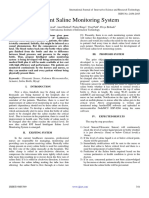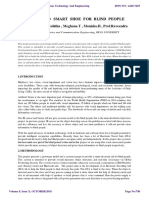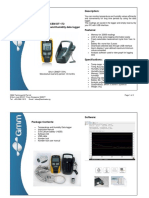Smart White Cane - An Elegant and Economic Walking Aid
Smart White Cane - An Elegant and Economic Walking Aid
Uploaded by
AJER JOURNALCopyright:
Available Formats
Smart White Cane - An Elegant and Economic Walking Aid
Smart White Cane - An Elegant and Economic Walking Aid
Uploaded by
AJER JOURNALOriginal Title
Copyright
Available Formats
Share this document
Did you find this document useful?
Is this content inappropriate?
Copyright:
Available Formats
Smart White Cane - An Elegant and Economic Walking Aid
Smart White Cane - An Elegant and Economic Walking Aid
Uploaded by
AJER JOURNALCopyright:
Available Formats
American Journal of Engineering Research (AJER)
2014
American Journal of Engineering Research (AJER)
e-ISSN : 2320-0847 p-ISSN : 2320-0936
Volume-03, Issue-10, pp-84-89
www.ajer.org
Research Paper
Open Access
Smart White Cane An Elegant and Economic Walking Aid
Rohit Sheth1, Surabhi Rajandekar2, Shalaka Laddha3, Rahul Chaudhari4
1234
Department of Electronics and Telecommunication Engineering,PVGs College of Engineering and
Technology,Pune
ABSTRACT:the main aim of this research paper is to provide a simple, affordable yet an efficient solution for
the visually impaired. The idea behind the design of the stick was to keep it structurally similar i.e. thin,
lightweight and easy to handle, yet give an active feedback to the user regarding hazards in his walking path.
The smart white cane uses the ultrasonic sensors arranged in such a way that it detects pits, potholes,
downfalls, a staircase ( up and down), low lying and knee level obstacles and even those above the waist. The
user is notified about the same by the pre-recorded sound messages and a haptic feedback in form of vibrations.
This can considerably alleviate the risk of the user injuring himself.
INDEXTERMS: ATMega328,Ultrasonicsensor, Sound IC,White cane, walking aid.
I.
INTRODUCTION
There are approximately 37million people across the globe who are blind, over 15 million are from
India.Even for the non-visually impaired the congestion of obstacles is sometimes problematic, its even worse
for the visually impaired. People with visual disabilities are often dependent on external assistance which can be
provided by humans, trained dogs, or special electronic devices as support systems for decision making.
Existing devices are able to detect and recognize objects that emerge on the floor, but a considerable risk is also
includes the objects that are at a sudden depth, or obstacles above waist level or stairs. Thus wewere motivated
to develop a smart white cane to overcome these limitations.The most common tool that the blind currently use
to navigate is the standard white cane. We decided to modify and enhance the walking cane, since blind are only
able to detect objects by touch or by cane. The user sweeps the caneback and forth in front of them. When the
cane hits an object or falls off of the edge of a stair, the user then becomes aware of the obstacle sometimes too
late. We wanted to provide additional feedback to the user to warn him of objects before he runs into them. We
accomplished this goal by adding ultrasonic sensors at specific positions to the cane that provided information
about the environment to the user through audio feedback.
Smart white cane is specially designed to detect obstacles which may help the blind to navigate carefree. The vibration feedback and the audio messages will keep the user alert and considerably reduce accidents.
The cane will warn whenever there are steps ahead and communicate whether they are going up or down
accordingly. The intensity of vibrations is an indication of the closeness of an obstacle in the walking path of the
user.
II.
LITERATURE SURVEY
Numerous attempts have been made in the society to help the blind. Project Prakash [1] is a
humanitarian mission to help the blind children especially by training them to utilize their brains to learn a set o
objects around them. In [2], the stick has a ping sonar sensor to sense the distant objects. It also has a wet
detector to detect the water. The micro-controller used is PIC microcontroller. The microcontroller circuit is on
the outside of the stick but is protected with a code so its security cannot be breached. The only feedback given
to the user is through the vibration motor.In [3], three sensors are used viz. ultrasonic, pit sensor and the water
sensor. Even this is a PIC based system. The feedback given is through the vibration as well as the
speaker/headphones. There is a GPS system where-in the user has to feed his location. No information on how a
blind man would do that. Also they havent mentioned anything about the size and shape of their cane and
neither about the placement of their circuitry.
www.ajer.org
Page 84
American Journal of Engineering Research (AJER)
2014
In [4], the author has made a detachable unit consisting of an ultrasonic sensor and a vibration motor. It
can be fit on any stick. It detects obstacles up to 3m. The vibration feedback varies in the intensity as the
obstacles comes nearer. Many different approaches have been taken with the primary purpose of creating a
technology to aid the visually impaired. The priorities set by different authors are different leaving a scope of
improvement in every application.
SYSTEM DESIGN AND IMPLEMENTATION
Figure 1:Block Diagram of the system
ULTRASONIC
SENSORS
ON/OFF SWITCH
MICROCONTROLLER
SOUND-IC
AtMega 328PU
VIBRATION
MOTOR
BATTERY
HEADPHONES
CIRCUIT DIAGRAM
SHEET 1-
Sheet 2: Sound IC (Hierarchical Block)
www.ajer.org
Page 85
American Journal of Engineering Research (AJER)
2014
The major components of the Smart White Cane are as follows:
ATMega328PU microcontroller
HC-SR04 Ultrasonic Sensor Module
Sound IC APR33a3
Vibration Motor
1.
ATmega328-PU C:
Features:
28 Pin I/O
RESET Pin NO. 1 (ACTIVE LOW)
Crystal Pins at 9-10 PIN
Software Declarable Serial Ports
2.
HC-SR04 Ultrasonic Sensor module
Features:
Working Voltage - DC 5 V
Working Current - 15mA
Working Freq. - 40Hz
Max Range - 4m
Min Range - 2cm
Measuring Angle - 15 degree
Trigger Input Signal - 10uS TTL pulse
Echo Output Signal - Input TTL lever signal and the range in proportion
Dimension - 45*20*15mm
3.
APR33a3
Features:
Operating Voltage Range: 3V ~ 6.5V
Single Chip, High Quality Audio/Voice Recording & Playback Solution
Voice Recording Length APR33A3- 680 sec
Audio Processor- Powerful 16-Bits Digital
Memory - Non-volatile Flash
Built-in Audio-Recording Microphone Amplifier
Resolution - 16-bits
Averagely 1, 2, 4 or 8 voice messages record & playback
www.ajer.org
Page 86
American Journal of Engineering Research (AJER)
III.
2014
HARDWARE DESCRIPTION
We decided to place our entire circuitry inside the cane.
The following considerations were made:
The Stick shouldnt be bulky.
Enough space to accommodate PCB and sensors.
PCB should be as small as possible.
Should be sturdy so as to protect the PCB.
Thus we choose a PVC pipe with a 3.5cm diameter and Height of 2.8feet.
To reduce the size of our PCB we choose all components as SMD with 0805 dimensions for capacitors and
resistors wherever possible and also an SMD package of voltage regulator 7805(T0-252-Dpack) along with
SOIC DIP packages for both Atmega328 and Apr33a3.
For vibration feedback, we provided the vibration motor at the handle (like the ones in mobile phones) and also
for voice messages we have given headset port also at the handle.
ON/OFF SWITCH
SENSOR 4
SENSOR 1: For down-step
SENSOR 3 & 2: For up-step
SENSOR 2: For obstacle in front
SENSOR 4: For obstacle
overhead
SENSOR2
SENSOR3
SENSOR1
www.ajer.org
Page 87
American Journal of Engineering Research (AJER)
IV.
2014
SALIENT FEATURES
Affordability - The estimated price for mass production should not exceed Rs.500. As majority of blind
population in the developing countries are poor, this provides an economical solution.
Versatility Apart from the low level obstacles even the ones above waist and types of staircases can be
determined.
Design
The bottom wheel The blind generally tap while sweeping which is avoided by using a wheel.
The entire circuitry along with the battery compartment is concealed inside the stick reducing the risk of
damage to the circuit and reducing bulkiness.
Handle ON/OFF switch, vibration feedback and the audio jack is provided on the handle itself.
Audio feedback Short pre-recorded messages informing the user about the obstacles are played. The
priority of the obstacles is set on the basis of the risk
V.
CONCLUSION
The smart white cane is a practically feasible product and convenient to carry around like any other
walking stick. This could also be considered a crude way of giving the blind a sense of vision. This also reduces
the dependency on other family members, friends and guidance dogs while walking around. It can serve as a
benchmark in aid for the blind like crutches are for the paraplegic.
www.ajer.org
Page 88
American Journal of Engineering Research (AJER)
2014
Future Scope: A global positioning method will used to find the position of' the user using the global
positioning system (GPS) and guidance to their destination will be given to the user by voice navigation.A wallfollowing function can also be added so that the user can walk straight along a corridor in an indoor
environment. Some more applications like vehicle detection, slippery floor, on-coming vehicle detection and
fire or smoke alarm can also be included.
REFERENCES
[1]
[2]
[3]
[4]
[5]
Project Prakash http://web.mit.edu/bcs/sinha/prakash.html
Mohammad Hazzaz Mahmud, Smart walking stick - an electronic approach to assist visually disabled persons
http://www.ijser.org/researchpaper%5CSmart-walking-stick-an-electronic-approach-to-assist- visually-disabled-persons.pdf
G.Gayathri, Smart Walking Stick for visually impairedhttp://ijecs.in/issue/v3-i3/8%20ijecs.pdf
Singh Vaibhav, 'SMART CANE FOR THE VISUALLY IMPAIRED: DESIGN AND CONTROLLED FIELD TESTING OF AN
AFFORDABLE OBSTACLE DETECTION SYSTEMhttp://assistech.iitd.ernet.in/doc/Transed2010_Smar t_Cane.pdf
Mohd Helmy Abd Wahab, Smart Cane: Assistive Cane for visually impaired people
http://arxiv.org/ftp/arxiv/papers/1110/1110.5156.pdf
www.ajer.org
Page 89
You might also like
- T24 Data Migration Tool - DMIG T24 - Reference Guide V1.3Document165 pagesT24 Data Migration Tool - DMIG T24 - Reference Guide V1.3Chandrashekhar R100% (5)
- An ECG Intelligent Monitoring System With MSP430 MicrocontrollerDocument6 pagesAn ECG Intelligent Monitoring System With MSP430 MicrocontrollerArash MinNo ratings yet
- Mobile Call GSM Alarm System: User's ManualDocument26 pagesMobile Call GSM Alarm System: User's Manualtokuro_22No ratings yet
- 2.development of Blind Assistive Device in Shopping MallsDocument4 pages2.development of Blind Assistive Device in Shopping MallsJashuvaNo ratings yet
- 03 SDD Solution Design DocumentDocument32 pages03 SDD Solution Design Documentapi-312045117No ratings yet
- Guide Name Presented By: Mr. Mukul Kumar Singh Amit Yadav (13EE08)Document19 pagesGuide Name Presented By: Mr. Mukul Kumar Singh Amit Yadav (13EE08)paritosh kushwahaNo ratings yet
- Intelligent Walking Stick For Elderly and Blind People IJERTV9IS030043Document4 pagesIntelligent Walking Stick For Elderly and Blind People IJERTV9IS030043JoshuaNo ratings yet
- Ultrasonic Navigation System For The BlindDocument41 pagesUltrasonic Navigation System For The BlindGagandeep SinghNo ratings yet
- Ecg Monitoring SystemDocument7 pagesEcg Monitoring SystemGestión WebNo ratings yet
- Ultrasonic Navigation For Blind With Audio Interface DocumentationDocument55 pagesUltrasonic Navigation For Blind With Audio Interface DocumentationGoutham Raj Mode60% (5)
- Smart Stick For Visually ImpairedDocument6 pagesSmart Stick For Visually ImpairedAnonymous izrFWiQNo ratings yet
- Visually Impaired People Monitoring in A Smart Home Using Electronic White CaneDocument10 pagesVisually Impaired People Monitoring in A Smart Home Using Electronic White CaneAnonymous Gl4IRRjzNNo ratings yet
- A Smart Wearable Guiding Device For The Visually Impaired PeopleDocument7 pagesA Smart Wearable Guiding Device For The Visually Impaired PeopleIJRASETPublicationsNo ratings yet
- Smart System For The BlindDocument4 pagesSmart System For The BlindInternational Journal of Innovative Science and Research TechnologyNo ratings yet
- Automatic Room Light Controller Using PIDocument5 pagesAutomatic Room Light Controller Using PIGifty Renacido100% (1)
- Pavi ppt-1Document21 pagesPavi ppt-1Priya KabirNo ratings yet
- Multi-Functional Blind Stick For Visually Impaired PeopleDocument5 pagesMulti-Functional Blind Stick For Visually Impaired PeopleRaghu BNo ratings yet
- Blind Person Smart StickDocument33 pagesBlind Person Smart StickErole Technologies Pvt ltd Homemade EngineerNo ratings yet
- Gesture VocalizerDocument20 pagesGesture Vocalizerchandan yadavNo ratings yet
- Blind PDFDocument6 pagesBlind PDFNelarapuMaheshNo ratings yet
- SRSA. Ppt-1Document15 pagesSRSA. Ppt-1Santhoshi RupaNo ratings yet
- Face Mask DetectionDocument44 pagesFace Mask DetectionRasool ReddyNo ratings yet
- PDF - Next Step Home Automatio Final Paper 150919Document6 pagesPDF - Next Step Home Automatio Final Paper 150919Dr. Pinki Yadav YadavNo ratings yet
- A Smart Blind Stick For Aiding Visually Impaired PeopleDocument3 pagesA Smart Blind Stick For Aiding Visually Impaired PeopleInternational Journal of Innovative Science and Research TechnologyNo ratings yet
- Smart CaneDocument6 pagesSmart CaneAL IshaNo ratings yet
- Smart Assistive Device For Visually Impaired People IJERTV4IS030921Document6 pagesSmart Assistive Device For Visually Impaired People IJERTV4IS030921Sandèép YadavNo ratings yet
- E Notice Board - 2Document4 pagesE Notice Board - 2Magical MKNo ratings yet
- Sensors On 3d DigitizationDocument24 pagesSensors On 3d DigitizationprincegirishNo ratings yet
- Intelligent Traffic Control System For Smart AmbulanceDocument16 pagesIntelligent Traffic Control System For Smart AmbulanceShivendu PandeyNo ratings yet
- IOT Based Air Sound Pollution Monitoring System Ijariie8490Document4 pagesIOT Based Air Sound Pollution Monitoring System Ijariie8490Suri Babu100% (3)
- Blue Eyes PPT Priyanshi - 2Document22 pagesBlue Eyes PPT Priyanshi - 2Nidhi SinghNo ratings yet
- SMART HELMET - PPTDocument10 pagesSMART HELMET - PPTgigatekNo ratings yet
- Blind StickDocument9 pagesBlind StickADITI AGRAWALNo ratings yet
- Patient Monitoring System Using GSM For Hospitals and Old Age HomesDocument5 pagesPatient Monitoring System Using GSM For Hospitals and Old Age Homesvgmanjunatha100% (1)
- Advanced Voting Machine Using Face RecognitionDocument25 pagesAdvanced Voting Machine Using Face Recognitionritu OfficialNo ratings yet
- Sign Laguage To Text Convertor - Synopsis - Docx - Google DriveDocument12 pagesSign Laguage To Text Convertor - Synopsis - Docx - Google DriveAman BindNo ratings yet
- Skinput ReportDocument25 pagesSkinput ReportVenugopal Puthur100% (1)
- IOT Project Report: Solar Panel Monitoring SystemDocument13 pagesIOT Project Report: Solar Panel Monitoring SystemAnushka ShahNo ratings yet
- Minor Project Report 1Document26 pagesMinor Project Report 1Shanid PrasadNo ratings yet
- Finger Print Based Electronic Voting MachineDocument4 pagesFinger Print Based Electronic Voting Machinesagarsm2No ratings yet
- Bidirectional Visitor Counter With Security System and Automated Room Light ControllerDocument4 pagesBidirectional Visitor Counter With Security System and Automated Room Light ControllerInternational Journal of Innovative Science and Research TechnologyNo ratings yet
- Bluetooth Notice Board100Document16 pagesBluetooth Notice Board100rrajmane50No ratings yet
- IOT BASED HEALTH MONITORING SYSTEM - DakshDocument17 pagesIOT BASED HEALTH MONITORING SYSTEM - DakshMohit MehraNo ratings yet
- Design of Microcontroller Based Virtual Eye For The BlindDocument6 pagesDesign of Microcontroller Based Virtual Eye For The BlindijsretNo ratings yet
- Java RingDocument29 pagesJava RingAjay Gupta50% (4)
- Mini Project 6th SEMDocument24 pagesMini Project 6th SEMInvincible 2.0No ratings yet
- Automatic Street Light and Power Generation: Bachelor of Science (Information Technology)Document36 pagesAutomatic Street Light and Power Generation: Bachelor of Science (Information Technology)vivekNo ratings yet
- Human Hand Gestures Capturing and Recognition Via CameraDocument64 pagesHuman Hand Gestures Capturing and Recognition Via CameraBharathNo ratings yet
- Digital Scent TechnologyDocument27 pagesDigital Scent TechnologyAnshimaNo ratings yet
- Smart Real Time Health Monitoring System Using ArduinoDocument5 pagesSmart Real Time Health Monitoring System Using ArduinoSDS PRIORNo ratings yet
- Fingerprint Based Door Access System Using Arduino: August 2020Document6 pagesFingerprint Based Door Access System Using Arduino: August 2020Aramae DagamiNo ratings yet
- Bluetooth Based Smart Sensor NetworksDocument10 pagesBluetooth Based Smart Sensor NetworksSaugat PradhanNo ratings yet
- Intelligent Saline Monitoring SystemDocument3 pagesIntelligent Saline Monitoring SystemAnonymous izrFWiQNo ratings yet
- Touchscreen TechnologyDocument14 pagesTouchscreen TechnologyChirag VermaNo ratings yet
- Dr. Rajendra Gode Institute of Technology & Research: "Automatic Pothole Detection While Driving"Document20 pagesDr. Rajendra Gode Institute of Technology & Research: "Automatic Pothole Detection While Driving"Sahil PundNo ratings yet
- The Today and Future of WSN, AI, and IoT: A Compass and Torchbearer for the TechnocratsFrom EverandThe Today and Future of WSN, AI, and IoT: A Compass and Torchbearer for the TechnocratsNo ratings yet
- Building the Internet of Things with IPv6 and MIPv6: The Evolving World of M2M CommunicationsFrom EverandBuilding the Internet of Things with IPv6 and MIPv6: The Evolving World of M2M CommunicationsNo ratings yet
- Kavach: Cab Signalling & Automatic Train Protection System for Digital RailwaysFrom EverandKavach: Cab Signalling & Automatic Train Protection System for Digital RailwaysNo ratings yet
- Smart Walking Stick For Visually ImpairedDocument16 pagesSmart Walking Stick For Visually ImpairedAshwati Joshi100% (1)
- Integrated Smart Shoe For Blind People: M.V.S.Divija, M.Rohitha, Meghana.T, Monisha.H, Prof - RaveendraDocument5 pagesIntegrated Smart Shoe For Blind People: M.V.S.Divija, M.Rohitha, Meghana.T, Monisha.H, Prof - RaveendraSachin ShivannavarNo ratings yet
- Third Eye: BengaluruDocument5 pagesThird Eye: Bengalurupragati2002rktNo ratings yet
- Safety Guard For Blind Using 8051: Saneesh C T, Deepashree A V, Gagana Divya, Trupti AgrawalDocument2 pagesSafety Guard For Blind Using 8051: Saneesh C T, Deepashree A V, Gagana Divya, Trupti AgrawalAnanthu J VNo ratings yet
- 6-20kVA Online UPS - Europower5f741111da9eaDocument2 pages6-20kVA Online UPS - Europower5f741111da9eaDESTABILISATOR CHANNELNo ratings yet
- Online Shooping For Cosmetics Product - ProposalDocument3 pagesOnline Shooping For Cosmetics Product - ProposalVikramBhosale50% (2)
- VM SssssssDocument18 pagesVM Ssssssskalin3169899No ratings yet
- Medical Image Processing Using Python and Open CVDocument5 pagesMedical Image Processing Using Python and Open CVAndroidRumpersNo ratings yet
- DS8800 Performance Monitoring and Tuning PDFDocument726 pagesDS8800 Performance Monitoring and Tuning PDFdeng lijunNo ratings yet
- Reverse Engineering For BeginnersDocument920 pagesReverse Engineering For BeginnersAlton BrickhouseNo ratings yet
- Online Assessment Platfoem Project ReportDocument43 pagesOnline Assessment Platfoem Project Reportrohanjadhav2326No ratings yet
- The Open Systems Interconnection (OSI) Reference ModelDocument5 pagesThe Open Systems Interconnection (OSI) Reference ModelKunal KimatkarNo ratings yet
- LEVEL 2 Exercise For COCDocument7 pagesLEVEL 2 Exercise For COCMk Seifu Ethio100% (1)
- eInfoChips Interview QuestionsDocument2 pageseInfoChips Interview Questionsshafi hasmani100% (1)
- CN Unit-Ii NotesDocument30 pagesCN Unit-Ii NotesJeeva ArumugamNo ratings yet
- Philips Pronto Edit User GuideDocument30 pagesPhilips Pronto Edit User GuidestachiNo ratings yet
- A. Which Three PC's Were Released in 1977?Document2 pagesA. Which Three PC's Were Released in 1977?Namikaze Brymzke IINo ratings yet
- Juniper Networks Virtual Chassis Fabric TechnologyDocument8 pagesJuniper Networks Virtual Chassis Fabric TechnologyVan LeNo ratings yet
- Gi355 Data SheetDocument4 pagesGi355 Data SheetEliezer GonzalezNo ratings yet
- Programming Concept Using CDocument165 pagesProgramming Concept Using CnavaeeeNo ratings yet
- Asus Zc500tg MB Service Manual v1.0 150610Document26 pagesAsus Zc500tg MB Service Manual v1.0 150610J Carlos Diblin100% (1)
- Unit - 4 List, Tuples and DictionariesDocument10 pagesUnit - 4 List, Tuples and DictionariesJohn WilliamNo ratings yet
- Chapter 2. Introducing The UML: The Unified Modeling Language User Guide Second EditionDocument35 pagesChapter 2. Introducing The UML: The Unified Modeling Language User Guide Second EditionS M Akash100% (1)
- Cemdt 172Document2 pagesCemdt 172zubairNo ratings yet
- OtherDocument2 pagesOtherKatrina Mae IsipNo ratings yet
- VCO Non-Adjusting PLL FM MPX Stereo Demodulator With FM AccessoriesDocument16 pagesVCO Non-Adjusting PLL FM MPX Stereo Demodulator With FM AccessoriesGunawan AryantoNo ratings yet
- Part 8 - WiMAX SecurityDocument34 pagesPart 8 - WiMAX SecurityTân HoàngNo ratings yet
- SPM - 3chapter ThreeDocument52 pagesSPM - 3chapter ThreeGelata GirmayeNo ratings yet
- Sai Kumar Aindla: EducationDocument1 pageSai Kumar Aindla: EducationHaroldNo ratings yet
- A2 - 4 - 4 Mujfgltiplexers DeMultiplexersDocument4 pagesA2 - 4 - 4 Mujfgltiplexers DeMultiplexersEric GongNo ratings yet
- Paw - PBW Series (2-3W) PDFDocument9 pagesPaw - PBW Series (2-3W) PDFbillylu06No ratings yet
- Spark: Owner's ManualDocument5 pagesSpark: Owner's Manualjorge medinaNo ratings yet

























































































